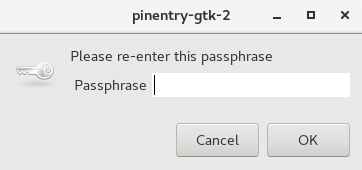文章目录
Linux下使用GPG(GnuPG)加密及解密文件
1. 简介
GNU Privacy Guard(GnuPG或GPG)是一种加密软件,它是PGP加密软件的满足GPL的替代物。GnuPG依照由IETF订定的OpenPGP技术标准设计。GnuPG用于加密、数字签名及产生非对称钥匙对的软件。
2.环境及版本
系统 centos 7
内核版本:3.10.0-693.el7.x86_64
gpg版本:2.0.22
3.GPG公钥生成
1.由于默认已经安装GPG,故直接输入“gpg --gen-key”并按回车键执行,然后输入“1”选择密钥种类,然后回车。
[db4@localhost ~]$ gpg --gen-key
gpg (GnuPG) 2.0.22; Copyright (C) 2013 Free Software Foundation, Inc.
This is free software: you are free to change and redistribute it.
There is NO WARRANTY, to the extent permitted by law.
Please select what kind of key you want:
(1) RSA and RSA (default)
(2) DSA and Elgamal
(3) DSA (sign only)
(4) RSA (sign only)
Your selection? 1
2.询问密钥对位数,默认为2048,本例中手动输入1024.
RSA keys may be between 1024 and 4096 bits long.
What keysize do you want? (2048) 1024
- 提示输入密钥对有效期,输入“0”(永不过期)并按回车键确定。
Please specify how long the key should be valid.
0 = key does not expire
<n> = key expires in n days
<n>w = key expires in n weeks
<n>m = key expires in n months
<n>y = key expires in n years
Key is valid for? (0) 0
- 提示将永不过期,输入“y”确认。
Key does not expire at all
Is this correct? (y/N) y
- 输入密钥对名称(本例中为cheshi)。
GnuPG needs to construct a user ID to identify your key.
Real name: cheshi
- 依次输入邮件地址和备注。
Real name: cheshi
Email address: ceshi@qq.com
Comment: NA
You selected this USER-ID:
"cheshi (NA) <ceshi@qq.com>"
- 询问是否修改或者确认,直接输入“o”确认。
Change (N)ame, (C)omment, (E)mail or (O)kay/(Q)uit? o
- 提示您需要设置私钥。
- 再次输入私钥。
- 系统需要时间生成密钥对,期间最好随机输入字符或移动鼠标等,有助于生成密钥对,结果如下图。
You need a Passphrase to protect your secret key.
We need to generate a lot of random bytes. It is a good idea to perform
some other action (type on the keyboard, move the mouse, utilize the
disks) during the prime generation; this gives the random number
generator a better chance to gain enough entropy.
We need to generate a lot of random bytes. It is a good idea to perform
some other action (type on the keyboard, move the mouse, utilize the
disks) during the prime generation; this gives the random number
generator a better chance to gain enough entropy.
gpg: key 70E8A292 marked as ultimately trusted
public and secret key created and signed.
gpg: checking the trustdb
gpg: 3 marginal(s) needed, 1 complete(s) needed, PGP trust model
gpg: depth: 0 valid: 1 signed: 0 trust: 0-, 0q, 0n, 0m, 0f, 1u
pub 1024R/70E8A292 2019-06-05
Key fingerprint = C54E 7282 49B7 51E8 00BB DCFA B8BD F821 70E8 A292
uid cheshi (NA) <ceshi@qq.com>
sub 1024R/26A8DC48 2019-06-05
4.查看公钥
[db4@localhost ~]$ gpg --list-key
/home/db4/.gnupg/pubring.gpg
----------------------------
pub 1024R/70E8A292 2019-06-05
uid cheshi (NA) <ceshi@qq.com>
sub 1024R/26A8DC48 2019-06-05
5.查看私钥
[db4@localhost ~]$ gpg --list-secret-keys
/home/db4/.gnupg/secring.gpg
----------------------------
sec 1024R/70E8A292 2019-06-05
uid cheshi (NA) <ceshi@qq.com>
ssb 1024R/26A8DC48 2019-06-05
6.导出公钥
1.命令格式
gpg -a --export 公私钥生成的用户 > 导出的公钥文件路径和文件名
2.命令样式
[db4@localhost ~]$ gpg -a --export ceshi > ceshi6666.asc
在当前的路径下面会生成一个ceshi6666.asc的公钥文件
3.备注
将上面的这个公钥文件ceshi6666.asc给需要加密的服务器一方即可
7.导出私钥
1.命令格式
gpg -a --export-secret-keys 公私钥生成的用户 >导出的私钥文件路径和文件名
2.命令样式
[db4@localhost ~]$ gpg -a --export-secret-keys ceshi > scheshi6666.asc
当前路径下面会生成一个私钥的文件scheshi6666.asc
8.加密文件
本机加密
输入“gpg --encrypt --recipient “cheshi” 123455”命令,意为使用公钥(名称为cheshi)加密名称为“123455”的文件。
[db4@localhost ~]$ gpg --encrypt --recipient "cheshi" 123455
该用户加密完毕后发现同目录下生成一个名为“原文件名.gpg”的文件(本例中为123455.gpg)
[db4@localhost ~]$ ls 1*
123455 123455.gpg
该用户输入“vim 123455.gpg”尝试查看加密文件,显示为乱码,将此加密文件(123455.gpg)发送给给你公钥的人。
[db4@localhost ~]$ vim 123455.gpg
84><8c>^CÏÍÏ<9e>&¨ÜH^A^Cý^_;<8a><86>¼U^[í^L2½àÉ^]²Bº'_<88>"ÎÖ^N^_^M^^Hì^_M<99>htH<÷T^O^U^_{ð0ÿÐh7wA¢s^P$:<88>Ô*á<92>ÀeB÷ü|õ<86>¯<89><99>^Wþ!ê^O^Dk-^C3^ZFpÞ^R<8e>ó÷²ì<9e>FfTbÙ´Q}ce$<98>^P!Àÿ·{<96>ä)Üí<8f>xv'<97><8f>ÿSñ<83><8c>Òq^A&ùv§ÛûÈìlû<89>Þ^@¹´¤¥ä÷Ë¡«Æ9ëRÐ(\g¶}4îÊùM)ð^\åJ^RgOX^O^[l©vZ^S^Y<8a>X 0Áü^?<8c>kÔXÚ&^Rßç^Nº^F^NDÒí<85>Æ^@_só^HÊÿ/qE}Å<80>^Pª³×^V<98>KM<88>E¸^A©³Ö^T#^DG^Z
~
其他电脑加密
导入公钥
该用户接收到公钥后,在命令行输入“gpg --import ceshi6666.asc”导入公钥。
[db2@localhost 模板]$ gpg --import ceshi6666.asc
gpg: 密钥 70E8A292:公钥“cheshi (NA) <ceshi@qq.com>”已导入
gpg: 合计被处理的数量:1
gpg: 已导入:1 (RSA: 1)
加密文件
该用户输入“gpg --encrypt --recipient “cheshi” 123455”命令,意为使用公钥(名称为cheshi)加密名称为“123455”的文件。 系统提示您是否确认公钥指纹正确,在导入他人的公钥前建议详细核对,输入“y”继续。
[db2@localhost 模板]$ gpg --encrypt --recipient "cheshi" 123455
gpg: 26A8DC48:没有证据表明这把密钥真的属于它所声称的持有者
pub 1024R/26A8DC48 2019-06-05 cheshi (NA) <ceshi@qq.com>
主钥指纹: C54E 7282 49B7 51E8 00BB DCFA B8BD F821 70E8 A292
子钥指纹: D8ED AE06 C208 D378 E562 12B9 CFCD CF9E 26A8 DC48
这把密钥并不一定属于用户标识声称的那个人。如果您真的知道自
己在做什么,您可以在下一个问题回答 yes。
无论如何还是使用这把密钥吗?(y/N)y
该用户加密完毕后发现同目录下生成一个名为“原文件名.gpg”的文件(本例中为123455.gpg)
[db2@localhost 模板]$ ls
123455 123455.gpg
该用户输入“vim 123455.gpg”尝试查看加密文件,显示为乱码,将此加密文件(123455.gpg)发送给给你公钥的人。 注意:在只有公钥的情况下,加密后的文件无法读取。
[db2@localhost 模板]$ vim 123455.gpg
<84><8c>^CÏÍÏ<9e>&¨ÜH^A^Cÿ@PÎ,Ló<98>^Lo<9e>^Yú^L츩^D?6}<8b> ^W^@^E/·x^Pã{^]m@YOÜÌ,h5`^]^[ǧ[<86>.^XHïZ<8f>@ªsBÊ΢ÖnúA<98>ÍL×A^GìW³ L
<8e>ÂöZýYEN¬ë<80>®dÅÕ^_ì^O<97>î^F«AUÍ<8d>r3Xø^C<8c>ÙÙÊ^CÅ^Q^BFO΢ ¦p<8e>h#ävÒq^ADF^_>×<8f>« 1ÇìP.ÍSUyùV<85>LÄû^PÀb=^QN^R^Q½ãJ{{CH;^\Z^\<99>1Ï)üe ¤"<9f>vk¢ ó,¦È¶6^Zqxù^_¢{O_Éí<80>xª <98>@WÇù¹FO<94>è?¦DáÊ "<9f>;åÈ^^<91>6"<9a>ñ^Y¦/S<8b><8d>t9
9.解密文件
本机解密
输入“gpg --decrypt 123455.gpg > 123455”将加密文件解密。提示输入私钥密码,输入正确的私钥密码后解密成功。
[db4@localhost ~]$ gpg --decrypt 123455.gpg > 123455
You need a passphrase to unlock the secret key for
user: "cheshi (NA) <ceshi@qq.com>"
1024-bit RSA key, ID 26A8DC48, created 2019-06-05 (main key ID 70E8A292)
gpg: encrypted with 1024-bit RSA key, ID 26A8DC48, created 2019-06-05
"cheshi (NA) <ceshi@qq.com>"
其他电脑解密
导入公钥
将私钥导出发给需要解密的用户,解密的用户执行”gpg --import 私钥名称“,将私钥导入电脑中
[db2@localhost 模板]$ gpg --import scheshi6666.asc
gpg: 密钥 70E8A292:私钥已导入
gpg: 密钥 70E8A292:“cheshi (NA) <ceshi@qq.com>”未改变
gpg: 合计被处理的数量:1
gpg: 未改变:1
gpg: 读取的私钥:1
gpg: 导入的私钥:1
输入“gpg --decrypt 123455.gpg > 123455”将加密文件解密。提示输入私钥密码,输入正确的私钥密码后解密成功。
[db2@localhost 模板]$ gpg --decrypt 123455.gpg > 123455
您需要输入密码,才能解开这个用户的私钥:“cheshi (NA) <ceshi@qq.com>”
1024 位的 RSA 密钥,钥匙号 26A8DC48,建立于 2019-06-05 (主钥匙号 70E8A292)
gpg: 由 1024 位的 RSA 密钥加密,钥匙号为 26A8DC48、生成于 2019-06-05
“cheshi (NA) <ceshi@qq.com>”

输入“vim 123455”查看此文件,可正常浏览及编辑。
[db2@localhost 模板]$ vim 123455
dgsbvbsgf v
bgsfd vxsgbf
xvc
bgsfd xvc
s vfbxc
sf
xvc
gbsf v
~
10.卸载密钥对
如需卸载密钥对,输入“gpg --delete-secret-keys cheshi”卸载私钥(必须先卸载私钥,然后才可卸载公钥)。
[db2@localhost 模板]$ gpg --delete-secret-keys cheshi
gpg (GnuPG) 2.0.22; Copyright (C) 2013 Free Software Foundation, Inc.
This is free software: you are free to change and redistribute it.
There is NO WARRANTY, to the extent permitted by law.
sec 1024R/70E8A292 2019-06-05 cheshi (NA) <ceshi@qq.com>
要从钥匙环里删除这把密钥吗?(y/N)y
这是一把私钥!――真的要删除吗?(y/N)y
继续输入“gpg --delete-keys cheshi”卸载公钥。
[db2@localhost 模板]$ gpg --delete-keys cheshi
gpg (GnuPG) 2.0.22; Copyright (C) 2013 Free Software Foundation, Inc.
This is free software: you are free to change and redistribute it.
There is NO WARRANTY, to the extent permitted by law.
pub 1024R/70E8A292 2019-06-05 cheshi (NA) <ceshi@qq.com>
要从钥匙环里删除这把密钥吗?(y/N)y
查看,输入”gpg --list-key“,里面为空。
[db2@localhost 模板]$ gpg --list-key



























 1664
1664











 被折叠的 条评论
为什么被折叠?
被折叠的 条评论
为什么被折叠?










